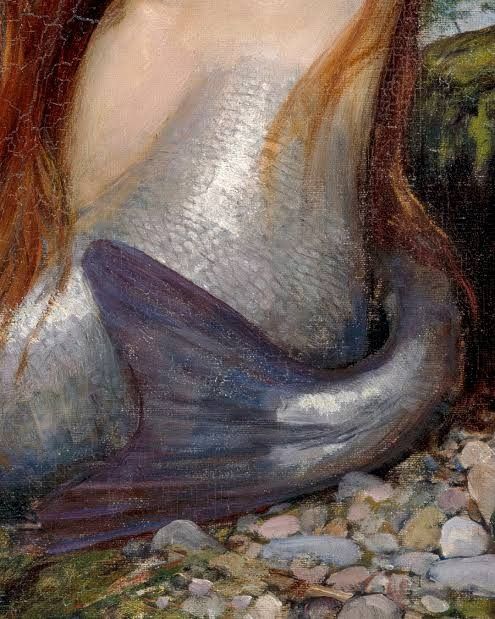If you are ever in Haarlem, Holland – you might be lucky enough to see the statue of a mermaid on the Oerkapkade. I’ll be honest with you, I have lived in Holland for more than 12 years, and I have never heard about a Dutch mermaid before, nor have most Dutch people. But why is that statue there? Is there really a mermaid swimming in the canals of Haarlem?

A creature floundering in the shallow water
Let’s go back to the 15th century, when Holland became a political entity and the name the Netherlands first appeared. In France, Joan of Arc was captured by Burgundian forces and burnt at the stake. Further north in the Lowlands, within the borders of what was then the Holy Roman Empire, terrible storms were raging. The gales were so strong that the dykes, which protected West Friesland, were breached, and the North Sea broke through and flooded the farmlands. In the late Middle Ages, during one of the storms, if we are to believe the people, something—a creature—was trapped in the waters of Purmermeer.

A group of women, who were gathering stranded fish for an easy meal, apparently discovered an unfortunate mermaid floundering in the shallow waters. Astonished, as one might expect, they somehow managed to carry the marvel to dry land, from where she was eventually transported to the city of Edam, presumably by boat to the western coast of the Zuider Zee, and then from Edam to the city of Haarlem. They believed that such a special creature would be much more suitable for a large city like Haarlem than for a small town, Edam.
But beauty or not, there was no exception; in order to make her way in the world she needed to work just like any other ordinary citizen (and not rely on her supernatural charms). With her heathen nakedness covered with ‘good Christian clothing’ She learned to spin clothes and clean, adapting to her new life. She began living as a human and eventually converted to Christianity. When she died, she was buried in the cemetery, just like any other humanbeing. In short, the mermaid was provided with the basics for an ordinary life in the Christian community in which she now found herself (how idyllic that might sound). This story was documented by a Christian monk, who even referred to the mermaid as ‘it’ during and after her process of humanization. The account also refers to the mermaid as ‘it’

, it was dressed in female attire, fed on cooked meat, had some notion of a deity, made its reverences when it passed a crucifix, lived some years at Haarlem (though it never retained an inclination for the water), and was allowed at its death a christian burial; and yet all efforts to teach even that Mermaid to speak proved ineffectual. It is this Haarlem Mermaid only (though without her clothes) that is represented upon our signs and in our coat-armour.” ~ Abridged extract from: The Asiatic Journal and Monthly Register for British India and its Dependencies, vol. XV, January to June, 1823. London.
The truth

How much truth is there in this story? We don’t even know for sure if she was a real half-human, half-fish hybrid. There wasn’t even a single mention of her tail. We simply don’t know. However, such stories do not emerge from nowhere, and perhaps the ‘mermaid’ was actually, a feral human. When I first heard this particular story, I was struck by the complete lack of fantasy in it. It seems as if the magic died before it could be born, revealing the naked brutality within us. If we ever discover a trapped human-fish hybrid in this modern world, it seems that the very last thing we would do—the least likely thing that might occur to us—would be to simply help her return to her ocean home.
The story about the Mermaid of Haarlem confronts how civilization tries to capture nature and tame its wildness. What if the mermaid was just a wild, naked human? The first thing we would try to do is cover her nakedness and teach her the rules of modesty and shame, adopting our own standards, beliefs, and moral codes—even if they are not right or universal. Isn’t that the first thing we teach our kids?
In this story, we can recognize the human desire (intentional or not) to change someone into what we think they should become. Is such a desire, really a form of conversion, or actually a form of coercion?
But it is also a story about otherness, which makes someone special, which makes them the unique individual that they truly are. We want so much to be special, and yet we deny it. How sad and old this story is, yet it can still be functional and educational in this modern world—only if we one day become old enough to read fairy tales again and to hear their morals, which fit our contemporary times even more than before.

Sources
Hawkwood. (2015, June 17). The Mermaid of Haarlem. Shadows in Eden https://shadowsineden.blogspot.com/2015/06/the-mermaid-of-haarlem.html
Diender, R. (2021, november 6). Mysterie opgelost: daarom staat er een beeld van een zeemeermin aan de Oekapkade. In de buurt. https://indebuurt.nl/haarlem/genieten-van/zeemeermin-haarlem-oerkapkade-standbeeld~83051/
Images
Bergen, D. (n.d). The Mermaid’s Journey. Shadows in Eden. https://shadowsineden.blogspot.com/2015/06/the-mermaid-of-haarlem.html
Jerichau-Baumann, E. (1873). Mermaid. [Oilpainting]

Leave a Reply